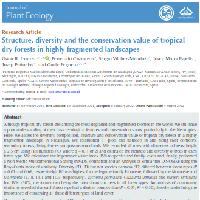Resumen
- Although tropical dry forests are among the most degraded and fragmented biomes in the world, we still only have a poor understanding of their basic ecological features and conservation status, particularly in the Neotropics. Here, we assess the diversity, composition, structure, and conservation value of tropical dry forests in a highly fragmented landscape in Nicaragua. Methods We established 31 plots and transects in and along river corridors, secondary forests, living fences, and pasture-woodlands. We recorded all trees with diameters at breast height ≥ 2.5 cm using Hill numbers ( qD, where q = 0, 1, or 2) and estimated the richness and diversity of trees in each forest type. We calculated the Importance Value Index (IVI) to species and family levels and, finally, performed a Non-Metric Multidimensional Scaling (NMDS) ordination and an Analysis of Similarities (ANOSIM) using the Bray-Curtis index of similarity. Important Findings Diversity ( 1D, 2D) but not species richness ( 0D) differed between forest types (P = 0.01 and 0.66, respectively). The Importance Value Index (IVI) was highest for the legume family Fabaceae, followed by the Moraceae and Malvaceae (27.8, 11.1, and 10.5, respectively). Vachellia pennatula, Guazuma ulmifolia, and Bursera simaruba had IVIs >30%, the former two being the most abundant trees in all forest types. An analysis of community similarity found that each forest type had a distinct composition (P < 0.01, R2 = 0.30), thereby underlining the importance of conserving all these different types of land cover.
